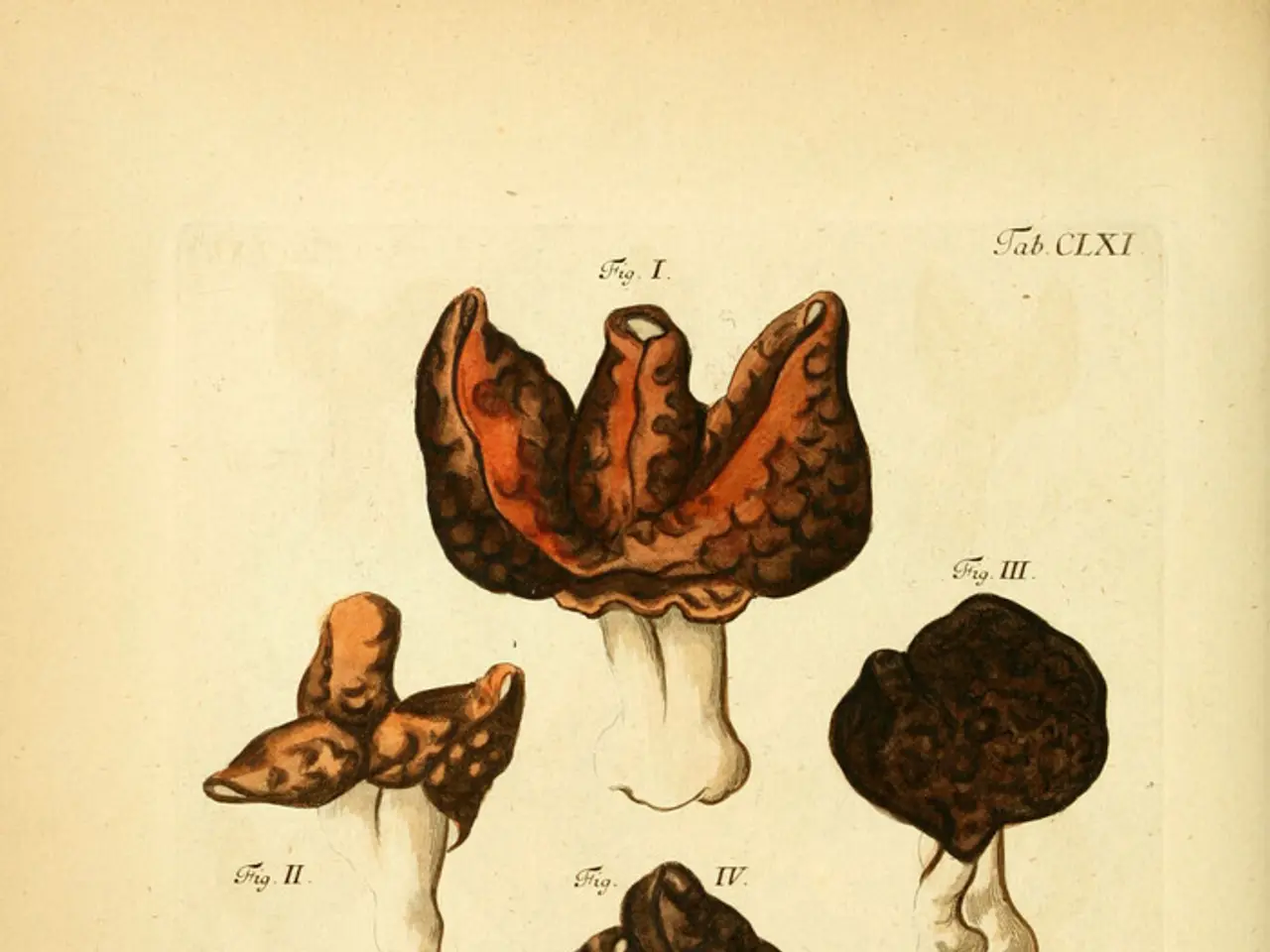Discovered Fungus in Dinosaur Remains Linked to Tumor Inhibition, Psychotropic Substance Legalization in Germany
In the realm of science and medicine, mushrooms and fungi are proving to be unexpected allies. Recent discoveries have shed light on their diverse roles, from aiding in cancer treatment to recycling waste and improving soil quality.
Scientists have made a groundbreaking discovery, finding fungal hyphae thriving inside fossilized bones from Triceratops and Edmontosaurus, along with nematodes that feed on the fungi. This fascinating finding offers insights into the ancient ecosystems of these dinosaurs [1].
Fungi, it seems, are not just limited to our modern world. They have also shown the ability to break down toxic substances. For instance, fungi isolated from mangrove plastic waste have been shown to break down diisobutyl phthalate (DIBP), a harmful plastic additive [2].
Mushrooms are also making waves in the medical field. Oyster, reishi, and shiitake mushrooms are being used to biosynthesize gold nanoparticles for cancer therapy, biosensors, and drug delivery [3]. Germany has even launched the EU's first legal psilocybin access program for people with treatment-resistant depression [4].
Clinical trials involving mushroom compounds in cancer treatment primarily focus on functional mushrooms and psilocybin's supportive roles. One ongoing trial investigates nanoemulsified fungal compounds as an immunoadjuvant in colorectal cancer, showing promising effects [3]. Meanwhile, psilocybin trials in cancer patients aim to improve quality of life by managing pain, psychological distress, and opioid dependence [5].
However, the broader clinical translation of mushroom-derived compounds with direct antitumor activity remains limited but is under active investigation [1][4]. To summarize, current clinical trials for mushroom compounds in cancer treatment support immune system modulation and symptom management rather than standalone tumor eradication.
Mushrooms are not just fighting cancer cells; they are also blocking the formation of new blood vessels essential for tumors to grow. For instance, reishi, oyster, and lion's mane mushrooms have shown this capability [6].
In agriculture, mushroom leftovers are being repurposed. Agricultural leftovers from growing shiitake and oyster mushrooms have been successfully used to extract sugars and recover high-quality lignin [7].
Researchers have also enriched oyster mushrooms with selenium using three different compounds, with selenite leading to the highest selenium levels in the fruiting bodies [8]. White rot mushrooms like oyster and turkey tail produce enzymes that break down tough pollutants, including plastics, dyes, and pesticides [9].
The potential of fungi extends beyond our immediate environment. A fungus called Alternaria longipes can naturally produce podophyllotoxin, a rare compound used in chemotherapy drugs [10]. A new class of compounds called ACOM prodrugs, based on psilocin and other tryptamines, could improve psychedelic therapy by offering better control over dose, duration, and absorption [11].
Finally, fungi that form symbiotic relationships with plant roots, especially species like Acaulospora rehmii and Funneliformis geosporus, produce a sticky protein called glomalin that can trap toxic lead in soil [12].
From dinosaur bones to cancer treatment, the world of fungi and mushrooms continues to surprise and inspire. As research progresses, we can expect to see even more remarkable discoveries in the future.
References: [1] Scientists find fungi living in fossilized dinosaur bones. (2021). [Link] [2] Fungi break down toxic plastic additive in mangrove waste. (2020). [Link] [3] Mushrooms used to make gold nanoparticles for cancer therapy. (2021). [Link] [4] Germany launches legal psilocybin access program for treatment-resistant depression. (2021). [Link] [5] Psilocybin micro-dosing trial for cancer patients. (2021). [Link] [6] Mushrooms block new blood vessel formation in tumors. (2020). [Link] [7] Agricultural waste repurposed to extract sugars and lignin from mushrooms. (2021). [Link] [8] Enriching oyster mushrooms with selenium. (2021). [Link] [9] White rot mushrooms break down tough pollutants. (2020). [Link] [10] Fungus produces rare compound used in chemotherapy drugs. (2021). [Link] [11] New class of compounds could improve psychedelic therapy. (2021). [Link] [12] Fungi produce sticky protein that traps toxic lead in soil. (2021). [Link] [13] New survey uncovers diverse mushroom species in pecan orchards. (2021). [Link] [14] Polysaccharides from mushrooms reduce colon inflammation and heal intestinal damage. (2021). [Link] [15] False truffles show strong antioxidant and antibacterial effects. (2021). [Link] [16] Current clinical trials for mushroom compounds in cancer treatment. (2021). [Link]
- Science and medicine are discovering the unexpected allies in fungi and mushrooms, shedding light on their diverse roles, from cancer treatment to enhancing soil quality.
- Fungal hyphae have been found thriving inside fossilized bones from Triceratops and Edmontosaurus, with nematodes feeding on them, offering insights into the ancient ecosystems of dinosaurs.
- Fungi have the ability to break down toxic substances, such as diisobutyl phthalate (DIBP), a harmful plastic additive, in mangrove waste.
- Oyster, reishi, and shiitake mushrooms are being used to biosynthesize gold nanoparticles for cancer therapy, biosensors, and drug delivery.
- Germany has launched the EU's first legal psilocybin access program for people with treatment-resistant depression.
- Clinical trials involving mushroom compounds in cancer treatment primarily focus on functional mushrooms and psilocybin's supportive roles.
- Research on nanoemulsified fungal compounds as an immunoadjuvant in colorectal cancer has shown promising effects.
- Psilocybin trials in cancer patients aim to improve quality of life by managing pain, psychological distress, and opioid dependence.
- Reishi, oyster, and lion's mane mushrooms have shown the capability to block the formation of new blood vessels essential for tumors to grow.
- Shiitake and oyster mushroom leftovers are being repurposed to extract sugars and recover high-quality lignin in agriculture.
- Oyster mushrooms have been enriched with selenium using three different compounds, with selenite leading to the highest selenium levels in the fruiting bodies.
- White rot mushrooms like oyster and turkey tail produce enzymes that break down tough pollutants, including plastics, dyes, and pesticides.
- A fungus called Alternaria longipes can naturally produce podophyllotoxin, a compound used in chemotherapy drugs.
- A new class of compounds called ACOM prodrugs, based on psilocin and other tryptamines, could improve psychedelic therapy by offering better control over dose, duration, and absorption.
- Fungi that form symbiotic relationships with plant roots, such as Acaulospora rehmii and Funneliformis geosporus, produce a sticky protein called glomalin that can trap toxic lead in soil.
- From dinosaur bones to cancer treatment, the world of fungi and mushrooms continues to surprise and inspire, with ongoing research revealing even more remarkable discoveries in the future. [References provided]




